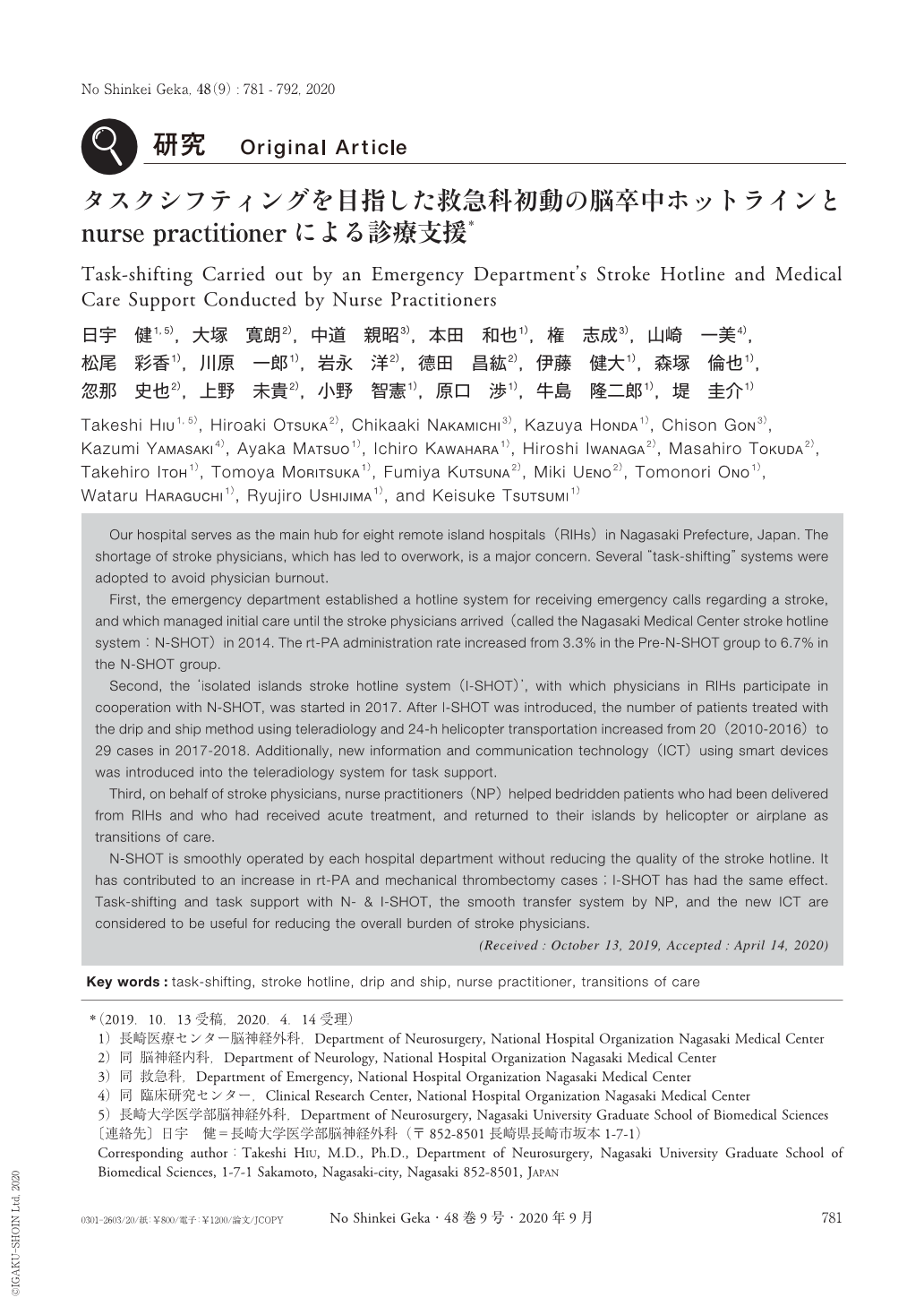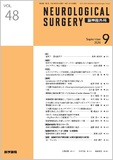Japanese
English
- 有料閲覧
- Abstract 文献概要
- 1ページ目 Look Inside
- 参考文献 Reference
Ⅰ.はじめに
超高齢社会を迎えた本邦において,脳卒中患者数は増加の一途をたどっており,この分野の救急医療を担う医師への業務的負荷は無視できない状況になりつつある.特に地方都市における医師不足の状況はますます深刻化し9),働き方改革の号令とも相まって,過重労働の問題がクローズアップされる昨今である17).
当施設は,長崎県央ならびに離島診療の中核を担う急性期病院である.離島常駐の脳卒中専門医は皆無であり,脳血管障害の救急患者に対しては,各離島の基幹病院(spoke:8施設)と当院(hub)間における遠隔画像伝送システムとヘリコプター(ヘリ)搬送(Nagasaki isolated islands telestroke system:NI-telestroke system)で,24時間対応してきた5,6).つまり,離島地域の脳卒中診療については,歴史的に一種のホットライン的体制がとられてきたとも言える.後述するようにこのシステムは,本土と離島双方の神経救急に常時対応する待機脳神経外科医への業務負荷が大きい.以上の背景から,本土救急外来の脳卒中患者には内科当直医が初期対応し,脳神経外科あるいは脳神経内科待機医をコールする初療体制をとっていた.一方,内科当直医は一般内科的救急患者への対応業務も多く,実際には適切なタイミングで脳卒中診療が行われないリスクもあった.
当施設でも脳卒中担当医・専門医の不足は大きな課題であるが,現実的には各医師にかかる過剰な業務負荷を軽減しつつ,遠隔地を含めた脳卒中医療の質を落とさず担保・継続していく必要がある.医師の「燃え尽き症候群」を予防する上でも,モチベーションを長期的に維持できる新たな診療システムの導入が必要となった.一地方都市の急性期病院における脳卒中診療体制の新たな試みを紹介し,それらのもたらす臨床的効果について検討する.
Our hospital serves as the main hub for eight remote island hospitals(RIHs)in Nagasaki Prefecture, Japan. The shortage of stroke physicians, which has led to overwork, is a major concern. Several “task-shifting” systems were adopted to avoid physician burnout.
First, the emergency department established a hotline system for receiving emergency calls regarding a stroke, and which managed initial care until the stroke physicians arrived(called the Nagasaki Medical Center stroke hotline system:N-SHOT)in 2014. The rt-PA administration rate increased from 3.3% in the Pre-N-SHOT group to 6.7% in the N-SHOT group.
Second, the ‘isolated islands stroke hotline system(I-SHOT)’, with which physicians in RIHs participate in cooperation with N-SHOT, was started in 2017. After I-SHOT was introduced, the number of patients treated with the drip and ship method using teleradiology and 24-h helicopter transportation increased from 20(2010-2016)to 29 cases in 2017-2018. Additionally, new information and communication technology(ICT)using smart devices was introduced into the teleradiology system for task support.
Third, on behalf of stroke physicians, nurse practitioners(NP)helped bedridden patients who had been delivered from RIHs and who had received acute treatment, and returned to their islands by helicopter or airplane as transitions of care.
N-SHOT is smoothly operated by each hospital department without reducing the quality of the stroke hotline. It has contributed to an increase in rt-PA and mechanical thrombectomy cases;I-SHOT has had the same effect. Task-shifting and task support with N- & I-SHOT, the smooth transfer system by NP, and the new ICT are considered to be useful for reducing the overall burden of stroke physicians.

Copyright © 2020, Igaku-Shoin Ltd. All rights reserved.


